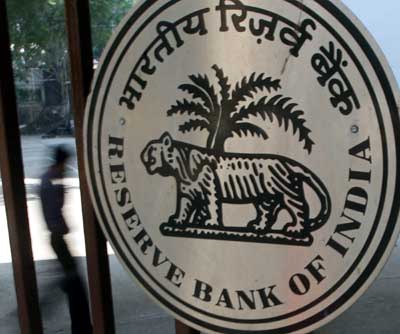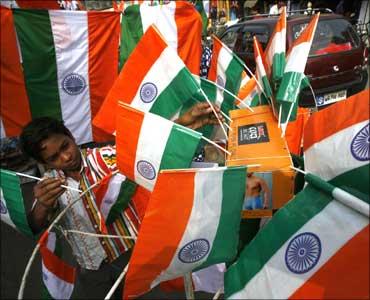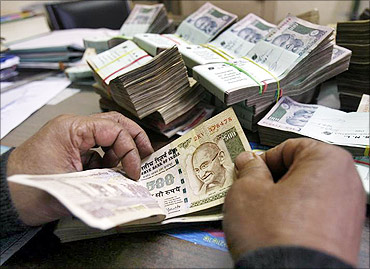Photographs: Reuters Sanjaya Baru
Last month the Reserve Bank of India put out the latest data on outward foreign direct investment (OFDI) from India.
The liberalisation of restrictions on Indian investment abroad has helped Indian companies acquire assets worldwide.
Investments by domestic Indian companies in overseas joint ventures and wholly owned subsidiaries were estimated at $16.7 billion in 2010-11, up from $10.3 billion in 2009-2010. Total outward FDI in the decade 2000-2010 has been estimated to be $80 billion.
. . .
Outward FDI: Has India Inc arrived or is leaving?
Photographs: Reuters
The RBI report notes, "The policy which was evolved as one of the strategies for export promotion and strengthening economic linkages with other countries has been streamlined significantly in scope and size, especially after the introduction of FEMA [Foreign Exchange Management Act] in June 2000. In the post-2003 period, the policy has enabled corporate entities and registered partnerships to invest in bona fide businesses abroad, currently to the extent of 400 per cent of their net worth, under the automatic route."
In terms of destination, the main target countries for such OFDI have been the United States, United Kingdom, Singapore, Mauritius, the Netherlands and British Virgin Islands, with Africa becoming an increasingly popular destination. The manufacturing sector reportedly occupied the largest share in India's OFDI in 2009-10.
| OUTWARD FDI FROM INDIA (April 2007 to May 31, 2011) ($ million) | ||||
| Period | Financial commitment | |||
| April-March | Equity | Loan | Guarantee issued | Total |
| 2007-2008 | 11,269.18 | 2,718.02 | 6,959.96 | 20,947.16 |
| 2008-2009 | 10,732.26 | 3,329.00 | 3,104.88 | 17,166.14 |
| 2009-2010 | 6,763.27 | 3,620.19 | 7,603.79 | 17,987.25 |
| 2010-2011 | 9,351.77 | 7,346.89 | 27,230.52 | 43,929.18 |
| April to May 2011 | 731.41 | 3,193.24 | 1,166.23 | 5,090.88 |
| As reported by Authorised Dealers in Form ODI | ||||
. . .
Outward FDI: Has India Inc arrived or is leaving?
Photographs: Reuters
The website of India Brand Equity Fund hails this as a sign of India Inc's growing global clout. It adds, "Indian companies, which are well experienced in dealing with overseas M&A [merger and acquisition] markets, are now back on the acquisition trail, with 40 per cent of those planning an acquisition in the next three years expecting their deals to be in foreign countries."
It quotes Mahad Narayanamoni, M&A partner with Grant Thornton India, as saying, "This reflects a coming of age for Indian businesses."
According to Mr Narayanamoni, "Indian companies are now more experienced in dealing with overseas M&A transactions and are considered serious contenders for acquiring global businesses. Acquiring global brands, gaining access to overseas markets and leveraging new technologies for Indian markets are some of the key drivers for outbound acquisitions by Indian companies."
. . .
Outward FDI: Has India Inc arrived or is leaving?
Photographs: Reuters
Without doubt, some of the OFDI represents export-promoting investment, and helps acquire new technology and new managerial skills, promote both corporate and country brands, secure access to raw materials and establish mutually beneficial relations of interdependence. Thus, rising OFDI represents a welcome trend.
However, it is worth asking how much of the spurt in OFDI represents the "coming of age of Indian business", and how much of it is a "flight of capital" from, as Indian business leaders are increasingly complaining, a worryingly difficult domestic business environment.
The man who built India's best (Hyderabad) and biggest (Delhi) airports, G M Rao, is busy scouting for business outside India, after bagging contracts in Turkey and Maldives.
. . .
Outward FDI: Has India Inc arrived or is leaving?
Photographs: Reuters
One of India's auto czars, Venu Srinivasan, has been reportedly following in the footsteps of his sambandhi, N R Narayana Murthy, taking part of his business to China. Murthy inaugurated the Shanghai campus of Infosys earlier this year, while Anil Ambani has been accessing funds and equipment from China.
India's rising corporate stars -- Analjit Singh, Sunil Mittal and Gautam Thapar, to name a few -- are spending an increasing amount of their time managing business abroad, since growth outside India seems easier to achieve.
More than half of Ratan Tata's business today is outside India and Shashi Ruia says his children want to take more of the family business away from India.
. . .
Outward FDI: Has India Inc arrived or is leaving?
Photographs: Reuters
Has Indian business "arrived" globally, or is it "departing" from India? Is this a new "secession of the successful", coming a generation after the flight of professional middle class talent that created the so-called global Indian diaspora?
Ironically, it comes two decades after India Inc got worried about the return of foreign capital to India. In 1993, one of the doyens of traditional Indian business, Hari Shankar Singhania, joined hands with Rahul Bajaj, L M Thapar, M C Arunachalam, Jamshyd Godrej, B K Modi and C K Birla to write a note to the P V Narasimha Rao government seeking a "level playing field" on which they could compete more effectively with multinationals.
Singhania refutes the charge that this group, dubbed the "Bombay Club", was seeking protection from external competition.
. . .
Outward FDI: Has India Inc arrived or is leaving?
Photographs: Reuters
Instead, he says, quoting from their note of 1993 (this writer has a copy of the original note), "The aim of Indian industry is to be as competitive as any of its peers in the world. Its vision is that it becomes multinational, in fact a world player. This can be achieved by concerted action by Industry and Government. Therefore, the range of economic reforms must be widened and its pace accelerated."
That, indeed, seems to have happened. But today Indian industry is fleeing home because of what it sees as the "drift in policy" and the "paralysis of decision-taking" in government.
Indian business seeks neither protection nor government subsidy, says Singhania, but an environment of greater trust and confidence in which it can take long-term investment decisions and speed up existing projects. It wants an end to what it sees as an environment of uncertainty, drift and growing hostility towards business and enterprise.
As the original manifesto of the so-called Bombay Club put it so eloquently two decades ago: "Indian Industry has been constantly urging for liberal business environment and welcomes the economic reforms which are directed towards integrating the Indian economy with the global economy. This will secure faster growth which alone will generate employment, increase exports and give substance to social objectives."
Is anyone listening?









article